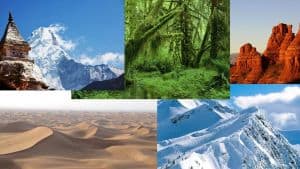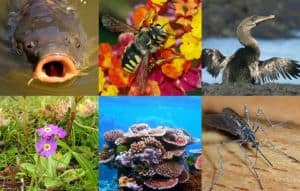
When you look around and observe nature, have you ever wondered how do animals and plants live according to the region and atmosphere? How they are dependent on each other for survival?
Scientists have categorized these regions into habitats and ecosystems in which living organisms either live independently or are interdependent.
Table of Contents
- A habitat is different from an ecosystem in that
- All living organisms in a habitat
- Different environments around the world
- The living organisms in a habitat are called
- The place where a community of plants and animals lives
- What needs of an organism are provided by its habitat
- Where do most of the worlds living things live
- Which of the following is not a component of the physical habitat in which organisms live?
A habitat is different from an ecosystem in that
A habitat is different from an ecosystem in that of size, where living and non-living organisms interact and thus consist of many habitats. A single ecosystem will include humans and numerous communities of all living organisms.
All living organisms in a habitat
All living organisms in a habitat are composed of living matter. This includes oxygen, hydrogen, carbon and nitrogen.
Carbon is the most important matter contained in living organisms. The natural environment and the area where an organism lives is called a habitat.
Different environments around the world

Different environments around the world give rise to different types of habitats. Each area is unique and specific for supporting biological life.
Polar Habitats
Polar habitats include the North and South poles, which are highest in latitude and receive the lowest sun energy, resulting in extremely low temperatures. These habitats are inhabited by polar bears, seals, whales, fish, and penguins at the South Pole only.
Aquatic Habitats
Aquatic habitats include freshwater (lakes, rivers, ponds), and coastal and marine habitats (seas, oceans).
Coastal Habitat
Coastal habitats are the juncture where aquatic habitat congregates with terrestrial habitat, including rock pools, beaches, and dunes.
Desert Habitat
Desert habitats cover 35% of the world’s land with extreme dryness, heat, arid conditions, and water scarcity. Cacti and sidewinder snakes are examples of adaptation to the environment by a population in a desert habitat.
Forests
Forests are a natural habitat covering 31% of the world’s land, dominated by lush green trees and categorized according to the world’s environment, including coastal, coniferous, tropical rain, and boreal forests.
Grasslands
Grassland habitats have warm to moderate weather conditions, consisting of open plains ideal for grazing animals. The soil surface protects the grass stems from extreme weather. Wild horses in Asia and bison in the US are examples of grassland habitat animals.
Tundra
Tundra habitats are also known as ice deserts with shallow temperatures and are dominated by wolves, reindeers, and penguins, located in Alaska and Canada.
Wetlands
Wetlands are waterlogged habitats covering 7% of the world’s land and act as a natural filtration system for cleaning freshwater habitats. In addition, they act as a protective barrier for the surrounding natural habitats.
Microhabitats
Microhabitats are small-sized habitats found in minute areas, including leaves’ underside, which has the perfect environment for bacterial growth.
Deep-Ocean
Deep-Ocean habitats are found in an extreme depth of aquatic environment and still has undiscovered areas due to high water pressure conditions.
The living organisms in a habitat are called

The living organisms in a habitat are called biotic components. For example, plants and animals are all living organisms that inhabit an environment.
All non-living things are called abiotic components, including soil and water. An organisms environment consists of biotic and abiotic components.
The place where a community of plants and animals lives
The place where a community of plants and animals lives is called an ecosystem. It is affected by geographical conditions including climate and water availability.
These conditions play a role in determining the types of organisms and its size. As a result, the ecosystem size can vary; from a microscopic cell to a gigantic continent.
The dynamics of any ecosystem include the following major processes:
· Flow of energy from sun
· Cycling of nutrients
Pond ecosystems are an example of animal ecosystem which includes snakes, ducks, swans, turtles, fish, insects and microorganism. It is a perfect example of a community of living organisms and their nonliving environment. The dynamics of pond ecosystem can be explained as:
Producers: photosynthetic algae and floating microorganisms are called producers and produce food by absorbing sunlight
Primary Consumers: Floating insects and eat producers
Secondary Consumers: Small fish, and frogs that eat primary consumers
Tertiary Consumers: Prawns and animals that eat secondary consumers
Decomposers: Fungi and bacteria that live at the bottom of the pond or in floating water and help the decaying process and form the reusable chemical substances for producers
These terms can be categorized by their interrelationships as follows:
Habitat: The physical location where an organism lives is termed its habitat
Population: All members of the habitat are collectively called a population
Community: All populations of organisms that live in a habitat
Ecosystem: A community and habitat where all organisms live and coordinate
Biosphere: Earths landscape and all of its life is known as the bioshpere
What needs of an organism are provided by its habitat
The needs of an organism provided by its habitat are food, water, and shelter. A habitat contains all sufficient items for an organism to survive.
Where do most of the worlds living things live
Most of the world’s living things live on land.
· Land (80%)
· Ocean (15%)
· Freshwater (5%)
Environmental differences within ecosystems are generally caused by natural or human interventions. These include flooding, droughts, seasonal changes, earthquake, tornados, deforestation, land conversions/developments, and pollution.
With this change, animals and plants adapt themselves to survive and search for food, water, and shelter. One species’ abandoned habitat is home for some other species.
For example, grassland forestation can lead to a habitat for squirrels and birds when grazing animals exit their habitats.
150 to 200 species of living organisms become extinct within a day due to the loss of their habitat. Therefore, worldwide organizations seek to conserve natural land and ocean habitats due to environmental changes.
Every species cannot survive human intervention in natural habitats.
The research found that the earth’s terrestrial surface has changed due to massive human activities.
The only solution for stopping human intervention and maintaining sustainability is to apply strict laws and regulations and regular monitoring to concerned authorities for protecting all living animals in a habitat.
In addition, scientists are also trying to discover new ecosystems for preserving nature. Jaich Maa is the new ecosystem discovered in 2018 underwater in the Gulf of California by research institutions of Mexico and US.
The study of the patterns in the distribution of plants and animals around the world is called Biogeography. It should be encouraged by every government for protecting our safe environment.
Which of the following is not a component of the physical habitat in which organisms live?
Bacteria is not a component of the physical habitat in which organisms live.
Sunlight, wind, sand and water are examples of the non living environment and components of the physical habitat.